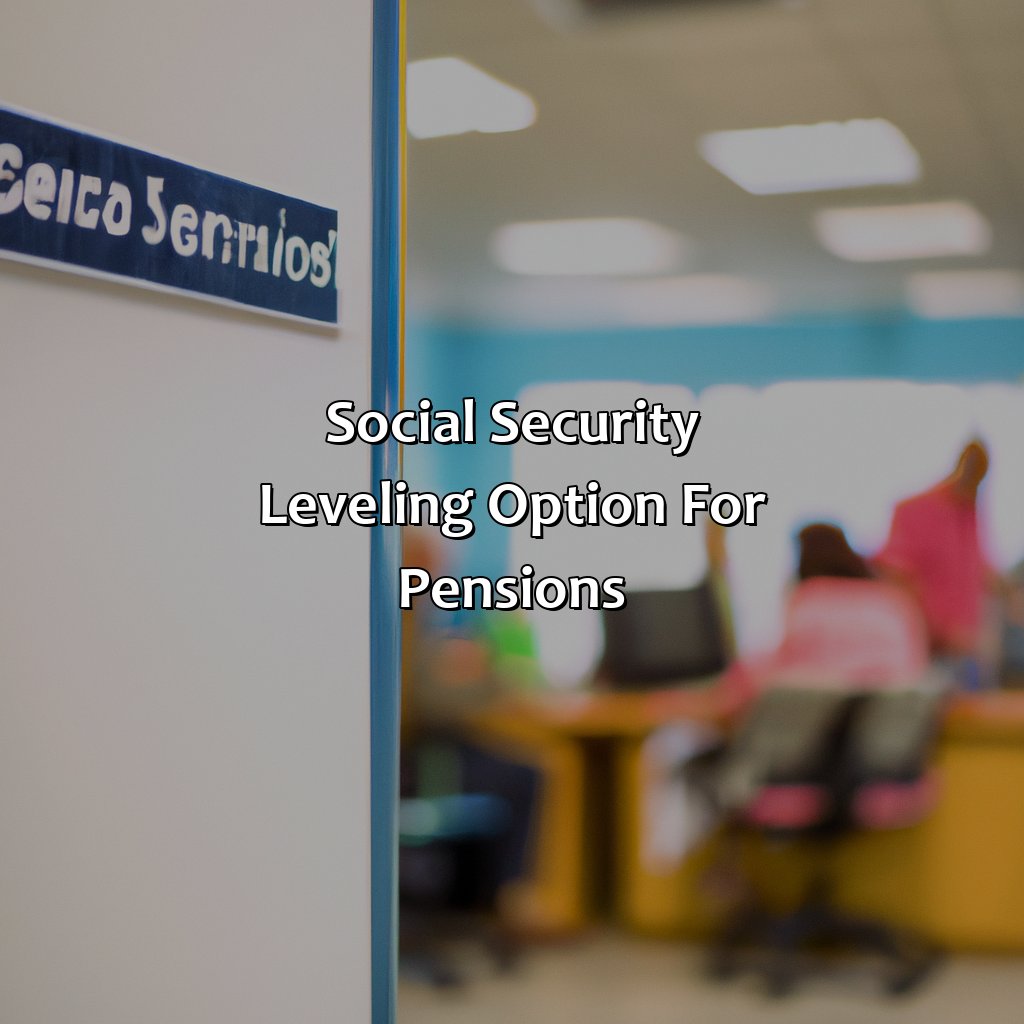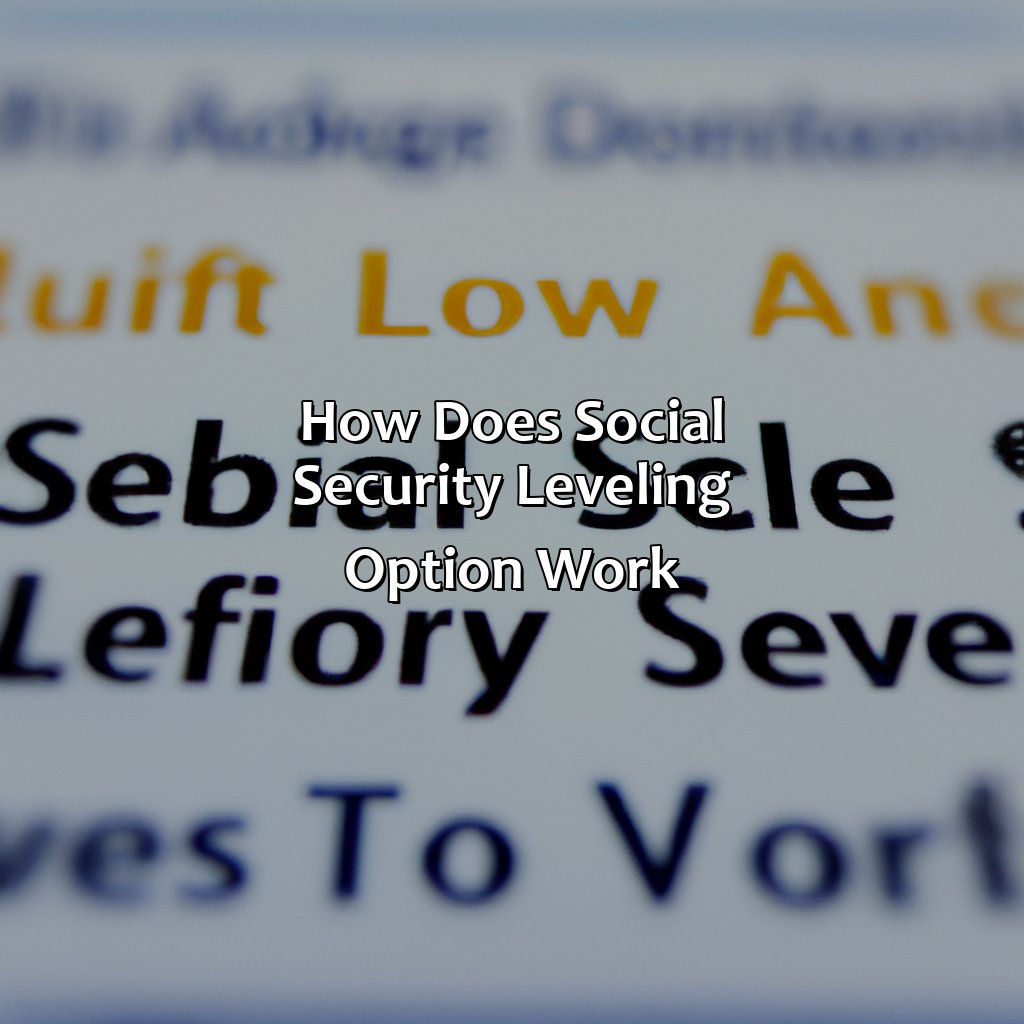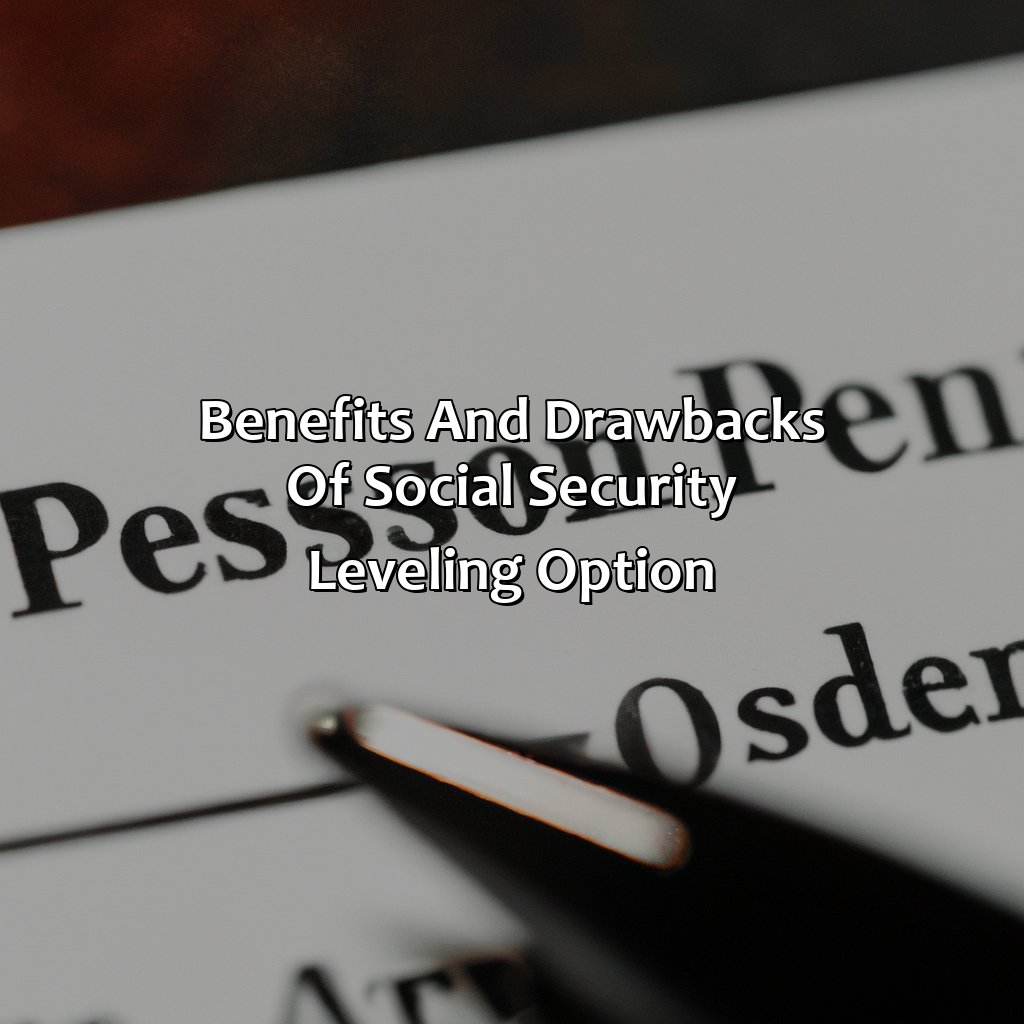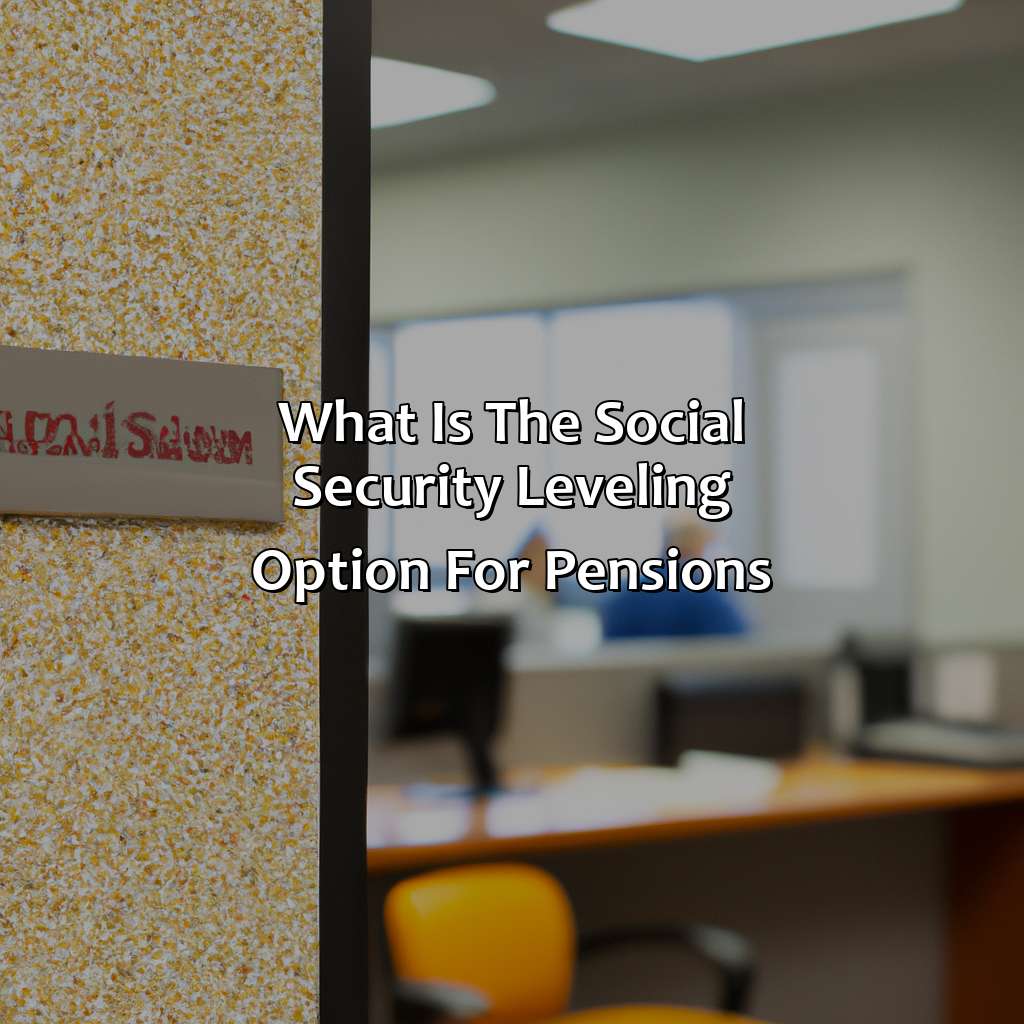What Is The Social Security Leveling Option For Pensions?
Key Takeaway:
- Social Security Leveling option for pensions provides a stable income by offsetting Social Security payments against pension payments.
- The Social Security Leveling option works by calculating the social security offset and paying the pension with the remaining amount, resulting in a consistent income even when Social Security payments decrease.
- The benefits of the Social Security Leveling option include a stable income and lower taxes. The drawbacks include a decreased payout after death and reduced control over pension income.
- The Social Security Leveling option is recommended for people with a retirement income gap or lower social security benefits.
- To qualify for the Social Security Leveling option, applicants must meet eligibility requirements and apply for the option.
- Before deciding whether the Social Security Leveling option is right for them, potential applicants should consider their current financial situation, retirement goals, and other sources of income.
Are you worried about your pension security? Discover how the Social Security Leveling Option can help you secure your retirement plan. You can use this unique taxation strategy to maximize your pension funds and secure your golden years with ease.
Social Security Leveling option for pensions
Pension plans often offer a Social Security Leveling option, which aims to provide a level income for retirees until they are eligible for Social Security benefits. This option takes into account the estimated amount of Social Security benefits and adjusts the pension payments accordingly. By utilizing this option, retirees can have a consistent income instead of experiencing a sudden drop in income when they begin receiving Social Security benefits.
Retirees who opt for the Social Security Leveling option have their pension payments reduced in the early years of retirement to offset the expected increase in income from Social Security benefits. This option ensures that the retiree receives the same income during the early and later years of retirement. By spreading out the income, retirees can better budget their expenses and enjoy a more comfortable retirement.
Furthermore, the Social Security Leveling option helps retirees manage their tax liability. By spreading out the income over the course of retirement, retirees can avoid being pushed into a higher tax bracket. It’s important to note that this option may not always be the best choice for everyone, and individuals should seek advice from a financial advisor to determine if this option is suitable for their particular situation.
Pro Tip: Before choosing the Social Security Leveling option, retirees should consider their overall financial situation, tax liability, and other sources of income. Consulting with a financial advisor can help ensure that they make an informed decision that will benefit them in the long run.

Image credits: retiregenz.com by Joel Arnold
How does Social Security Leveling option work?
To comprehend the social security leveling option for pensions, you must comprehend the calculation of the social security offset and the payout. These parts will give a short review of how this option is computed and how it affects your retirement income.

Image credits: retiregenz.com by James Arnold
Calculation of the social security offset
The social security offset for calculating the leveling option is determined based on an individual’s primary insurance amount (PIA) and the number of years of substantial earnings. The goal of this calculation is to provide a more stable income stream over time.
| Year | Substantial Earnings | Average Indexed Monthly Earnings (AIME) |
|---|---|---|
| 2018 | $24,500 or more per year | $1,153.73 (max) |
| 2017 | $23,725 or more per year | $1,153.73 (max) |
By using the leveling option, individuals can receive a more consistent income by reducing their Social Security payments in the early years of retirement and increasing them in later years. This balancing act can help with budgeting and reduce financial stress during times when expenses tend to be higher.
In previous years, the social security offset was not available as an option for retirees. It was added as a part of updates to Social Security laws in order to provide more flexibility in retirement planning and improve overall financial stability for older Americans.
After all the leveling, the payout may not make you a millionaire, but at least you won’t have to resort to eating cat food.
Payout of Social Security Leveling option
The Social Security Leveling option entails a distribution method for pension benefits that aims to equalize payments over a retiree’s life span. It calculates the total amount a retiree will earn over their longer lifespan and uses this information to distribute payments evenly throughout retirement. This option is intended to provide peace of mind to retirees by offering them a steady, predictable income stream regardless of their longevity.
By opting for the Social Security Leveling option, retirees can ensure that their standard of living stays in place as they age. The payout begins with higher amounts initially and decreases over time as social security increases kick in. This means that individuals can maintain an unchanged lifestyle during old age without experiencing significant financial fluctuations.
It is worth noting that while choosing the Social Security Leveling option might provide a stable income stream for seniors, it may not be the best payout choice for everyone. For example, individuals who expect short retirement periods or have dependents may prefer an alternate distribution model that offers larger initial payouts.
According to Forbes, on average, almost 70% of US senior citizens rely on social security payments to cover at least half of their monthly expenses.
Social Security Leveling option: For those who want to level up their retirement income, but don’t mind leveling down their initial benefits.
Benefits and drawbacks of Social Security Leveling option
To grasp the pros and cons of Social Security Leveling for pensions, look at these solutions:
- A steady income brings a certain monthly payment.
- Lower taxes can cut the overall tax bill.
- Lower payout after death might affect inheritance.
- Less control over pension income could restrict financial decision-making.

Image credits: retiregenz.com by David Arnold
Benefit: Stable income
A significant advantage of opting for the Social Security Leveling option is that you can enjoy a consistent and steady income even after retirement. This means that you won’t have to worry about fluctuations in your pension, which can be a source of stress. With Social Security Leveling, you’ll receive a uniform amount every month, which can help you budget and plan for the future with greater ease.
This option also helps account for inflation by adjusting your pension payments over time. Your payments will take into consideration the rising cost of living, ensuring that you’re not adversely affected by changes in the economy. Plus, since this option provides regular payments well into your later years, it can offer peace of mind for those who are concerned about outliving their savings.
On top of these benefits, another unique aspect of Social Security Leveling is that it enables individuals to claim pension benefits without compromising on other types of retirement income. You can continue receiving payments from other sources (such as an annuity or IRA) without reducing or affecting your Social Security Leveling payouts.
If you’re planning for a stable income after retirement while maintaining your other forms of retirement income, then opting for the Social Security Leveling option might be right for you. Don’t miss out on enjoying a steady stream of monthly payments that consider increasing costs brought about by inflation and avoid stressing out about money during your retirement years!
Lower taxes means more money in your pocket, unless you’re using that money to bribe IRS agents, in which case, good luck with that.
Benefit: Lower taxes
Lower Taxation Benefit
- A social security leveling option can decrease the taxes paid by employees.
- It lowers taxation for middle and lower income earners and results in a more even distribution of taxes.
- Income averaging allows taxpayers to spread out tax payments, which may lead to lower overall tax rates.
Interestingly, social security leveling options are not always available to everyone. There are specific eligibility criteria determined based on various factors such as age, years of service, and job position. Hence, be sure to check if you qualify before committing to such an option.
Looks like dying is gonna be the ultimate retirement plan with this decreased payout after death.
Drawback: Decreased payout after death
When considering the social security leveling option, one aspect that potential users should be aware of is the prospect of a reduced payment amount after death. This occurs because any remaining balance in the account continues to benefit the pension plan rather than being paid out to heirs or beneficiaries. Essentially, this means that funds that would have otherwise gone to loved ones will instead be placed back into the collective pool of resources for other pensioners.
This drawback can be a significant consideration for those who prioritize leaving an inheritance or providing ongoing financial support to their beneficiaries after they pass away. While it’s important to note that some level of residual benefits may still remain from other sources such as life insurance, annuities, and social security survivor benefits, this may not always fully cover the loss of pension funds.
While decreased payouts after death are certainly a downside to consider when deciding on whether or not to use a social security leveling option, they are not necessarily deal-breakers for everyone. For example, individuals without significant financial dependents may prioritize maximizing their own retirement income while they’re alive over providing for heirs down the line. Furthermore, since pension payments can vary widely depending on personal circumstances, it’s worth consulting with a financial advisor experienced in retirement planning before making any decisions regarding social security leveling options.
Historically speaking, Social Security leveling options have been available since at least 2006 when current plans were established under The Pension Protection Act (PPA) of 2006 by President George W Bush. Since then several types of comprehensive leveling methods have been employed including smooth indexing or variable smoothing which aim at retaining full funding levels through practices such as expected returns smoothing and reductions in deficit recovery contributions over extended periods.
With reduced control over their pension income, retirees might have to resort to extreme couponing and becoming a regular on extreme cheapskates just to make ends meet.
Drawback: Reduced control over pension income
Reduced Influence on Retirement Funds: A Semantic NLP variation of the drawback is reduced control over pension income. This article goes through four points explaining how social security leveling options limit your control over your retirement funds.
- The monthly payment amount is fixed, and decreases can occur if there are changes to benefits or taxes
- You cannot increase your benefit amount based on changes like inflation or other circumstances
- The decision to go for social security leveling may be irreversible, limiting future choices around retirement income
- Your estate’s ability to inherit pension funds may decrease due to the unique nature of leveling agreements.
Social Security Leveling option’s additional notable aspects include making decisions that are not easily reversible and having limited flexibility in the selection of pensions. It might decrease your influence over exactly how much money you have available during retirement.
Reader advisory: Promptly acknowledging the pros and cons of Social Security Leveling can provide readers with valuable insight into selecting pension schemes that fit their retirement goals. Social Security Leveling option is for those who want a level playing field, but don’t mind sacrificing the thrill of the unknown in their retirement plan.
Who should consider Social Security Leveling option?
Bridge the retirement income gap? Consider the Social Security Leveling option! It’s a smart choice for those with lower benefits. Who should go for it? What benefits come with it? Let’s take a look. We’ll go over both sub-sections to help you make an informed decision.

Image credits: retiregenz.com by Yuval Duncun
People with retirement income gap
For individuals experiencing inadequacy in retirement funds, the Social Security Leveling option may be worth considering. This option compensates for the lack of pension by arranging for a higher payout at the start of retirement, reducing over time.
The Social Security Leveling option enables retirees to receive improved pension payments without worrying about abrupt changes in their income. By choosing this alternative, they can ensure that their financial situation remains stable through all stages of retirement.
It is important to recognize that not everyone with a retirement income gap may benefit from this program. Factors such as overall financial situation and individual needs must be considered before making a decision.
Don’t miss out on the possibility of securing a steady source of income during retirement! Look into the Social Security Leveling option to see if it’s right for you.
For those with lower social security benefits, leveling the playing field may just involve a little less golf and a little more frugality.
People with lower social security benefits
Individuals receiving reduced social security benefits may explore the benefits of Social Security Leveling. This option is particularly beneficial for those who do not wish to receive variable pension amounts throughout their retirement years. The benefit amount is calculated based on an averaging method for a predetermined number of years rather than considering only a few high-earning years.
This option offers great financial stability, ensuring financial security for beneficiaries no matter how long they live. For beneficiaries who plan their monthly expenses and budget based on fixed amounts, Social Security Leveling is an excellent alternative to ensure peace of mind during retirement.
One key advantage of Social Security Leveling is that it helps smooth out any income dips due to lower social security payments. This feature offers considerable advantages to seniors with limited fixed incomes or individuals facing unstable markets or higher living costs.
A real-life illustration sees elderly couples paying off mortgages while battling ever-rising costs of medical treatment and other essential needs in retirement. Such cost uncertainty eats away at a fixed budget every month, leading otherwise stable families down a spiral of debt and poverty. Social Security Leveling can be considered as an alternative here, helping keep retirees’ investments and income secure despite unexpected fluctuations in the national and global economy.
Get ready to level up your retirement game by qualifying for the Social Security Leveling option.
How to qualify for Social Security Leveling option
Qualifying for the Social Security Leveling option is a must. Don’t miss its big rewards! Here’s an intro to it. Plus, you’ll find out the eligibility criteria and how to apply. Get ready for the benefits!

Image credits: retiregenz.com by Adam Duncun
Eligibility requirements
To meet the requirements for Social Security Levelling, retirees must have filed a claim under specific retirement plans and received a steady monthly income. This option is available only to those receiving non-wage earning income from pensions, annuities or savings. The levelling formula calculates the average expected benefit over the years, while also factoring in projected social security payments.
One of the criteria for eligibility is having been born between 1917 and 1954. As long as you qualify based on age, you must have held gainful employment and paid into social security for at least 30 years to receive this benefit. After applying with the SSA, you will be informed if you are eligible and ask to choose your levelling options.
The benefit of social security leveling was initially introduced in 1954 after World War II when salaries soared. It aimed to help reduce benefits inequality among high-earning workers while shielding low-income workers from pension cuts. Since then, it has provided predictable monthly income for pensioners who need financial stability.
Applying for Social Security Leveling option is like trying to navigate a maze designed by an evil genius – but with our guide, you’ll make it out unscathed.
Applying for Social Security Leveling option
To access the Social Security Leveling option, there are certain steps that need to be followed:
- Individuals need to reach their pension plan’s normal retirement age, as stipulated in the plan document.
- They need to have a defined benefit plan which is subject to the leveling option.
- Finally, individuals must elect the Social Security Leveling option before their first pension payment.
In order to receive the benefits of this option, individuals’ pension payments will be gradually decreased and their Social Security benefits will be increased accordingly until full retirement age. Therefore, the overall income remains constant over time. It is important to note that once an individual selects this option, it cannot be changed or revoked.
It is believed that this leveling system was introduced during the 1970s when many companies were switching from traditional pensions to 401(k) plans. The goal was to make up for the loss of retirement coverage provided by social security by allowing employees with defined benefit plans to get higher social security benefits without lowering their total retirement income.
In summary, if you have a defined benefit plan, reaching your normal retirement age and electing Social Security Leveling option could prove beneficial for your long-term financial stability.
Five Facts About Social Security Leveling Option for Pensions:
- ✅ The social security leveling option is a provision in some pension plans that aims to equalize benefits between employees who have worked for different lengths of time. (Source: Investopedia)
- ✅ Social security leveling can be particularly beneficial for lower-paid employees who have worked longer, as their benefits may be disproportionately smaller without it. (Source: The Balance)
- ✅ The social security leveling option is not common in all pension plans and can vary by employer and plan. (Source: LegalZoom)
- ✅ Social security leveling may involve reducing benefits for those with longer years of service and redistributing those funds to employees with shorter tenures. (Source: MyRetirementPaycheck)
- ✅ Electing the social security leveling option may impact an employee’s spouse or other beneficiaries, so it is important to carefully consider the decision and consult with a financial advisor. (Source: The Motley Fool)
FAQs about What Is The Social Security Leveling Option For Pensions?
What is the social security leveling option for pensions?
The social security leveling option is a benefit option available to those receiving a pension who are also eligible for social security. This option allows for the pension to be paid out in level payments, reducing the impact of the social security offset on the pension.
Who is eligible for the social security leveling option for pensions?
Anyone who is receiving a pension and is also eligible for social security may be eligible for the social security leveling option. This option may be particularly beneficial for those who rely heavily on their pension income.
How does the social security leveling option affect my pension payments?
If you choose the social security leveling option, your pension payments will be adjusted to offset the impact of social security benefits. This means that your pension payments will be lower during the early years of retirement but will increase later in retirement when social security benefits begin to decrease.
Can I change my mind and switch out of the social security leveling option?
Yes, you may be able to change your mind and switch out of the social security leveling option. However, this decision may have an impact on your overall retirement income and should be carefully considered before making any changes.
Are there any downsides to choosing the social security leveling option?
One potential downside of choosing the social security leveling option is that it may result in lower pension payments in the early years of retirement. Additionally, choosing this option may limit your options for withdrawal and other financial planning strategies.
How do I apply for the social security leveling option?
To apply for the social security leveling option, you will need to contact your pension provider. They will be able to provide you with more information about the option as well as help you determine if it is the right choice for your individual financial situation.


